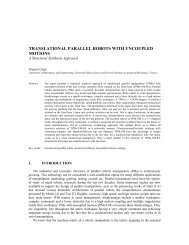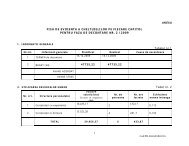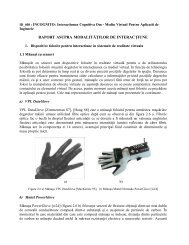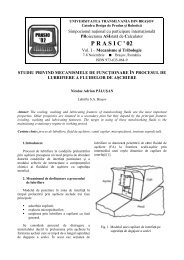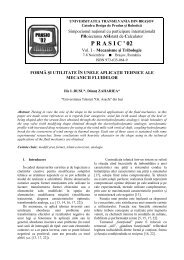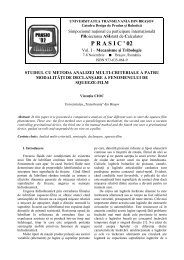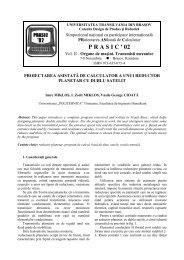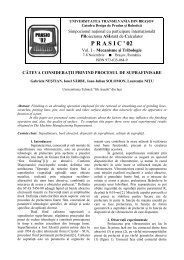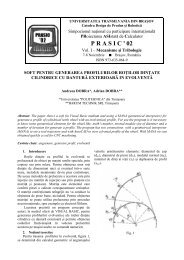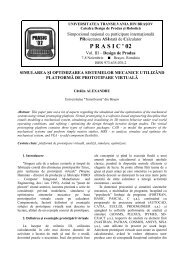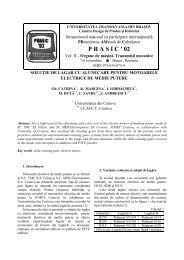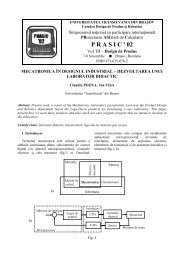real-time mbs formulations: towards virtual engineering
real-time mbs formulations: towards virtual engineering
real-time mbs formulations: towards virtual engineering
You also want an ePaper? Increase the reach of your titles
YUMPU automatically turns print PDFs into web optimized ePapers that Google loves.
176 J. Cuadrado, M. Gonzalez, R. Gutierrez, M.A. Naya<br />
3.2 Serial robot<br />
The PUMA robot, designed by Unimation & Co. and shown in Figure 3, is an example of a 6<br />
degrees-of-freedom serial manipulator. It has been often used by different authors [9] to illustrate<br />
methods and procedures in several areas of robotics. In this work, the robot has been taken as an<br />
example of multibody system undergoing changing configurations.<br />
Starting from rest, torques at the six hinges of the robot are provided so that, in a <strong>time</strong> of 2 s, it<br />
arrives at a new position in the space, again in rest conditions. Once<br />
the new position has been reached, a point of the hand is attached to<br />
the ground, so that the robot loses 3 degrees-of-freedom. In this<br />
new configuration, torques are applied to the three rotational pairs<br />
of the hand, and a second maneuver, which lasts 4 s and ends with<br />
rest conditions, is performed. Finally, the robot is released from its<br />
attachment and returned in 2 s to the initial position by torques<br />
acting at the six revolute joints, once more finishing the maneuver<br />
at rest conditions. Therefore, the total simulation <strong>time</strong> is 8 s.<br />
Table 2 illustrates the results obtained when applying the<br />
proposed method. The error has been calculated as the distance, in<br />
Figure 3. PUMA robot<br />
mm, between the hand positions at initial and final <strong>time</strong>s (which,<br />
ideally, should be coincident).<br />
Table 2. Error and CPU-<strong>time</strong> for the PUMA robot.<br />
∆t (s) Error (mm) CPU-<strong>time</strong> (s)<br />
0.01 0.53 6.25<br />
0.05 3.4 1.92<br />
0.1 no convergence no convergence<br />
From the results reported in Table 2, it is obvious that the formulation deals well with changing<br />
configurations. As in the previous example, large <strong>time</strong>-steps can be taken with acceptable accuracy.<br />
Although the example has been implemented in the computing environment Matlab, <strong>real</strong>-<strong>time</strong><br />
performance is comfortably achieved.<br />
3.3 Four-bar mechanism with assembly defect<br />
The third example is a four-bar mechanism, shown in Figure 4. The angular velocity ω of the left<br />
crank is kinematically guided at a constant rate of 1 rad/s. Gravity effects are neglected. Bar lengths<br />
are: AB=0.12 m; BC=0.24 m; CD=0.12 m; AD=0.24 m.<br />
B<br />
C<br />
ω<br />
5 o<br />
A<br />
D<br />
Figure 4. Four-bar mechanism with assembly defect.<br />
Typically, the axes of rotation of the four revolute joints are orthogonal to the plane of the<br />
mechanism, and then it moves as a planar mechanism. However, in this case, the axis of rotation of<br />
joint C is at a 5 degree angle with respect to the plane normal to simulate an assembly defect in the<br />
mechanism. If the bars were rigid, no motion would be possible as the mechanism would lock. For<br />
elastic bars, motion becomes possible, but generates large internal forces. Physical properties of the



